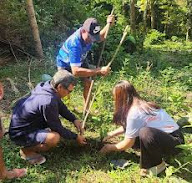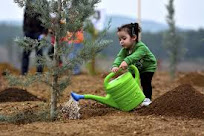Food Crisis Series 42
Live in an Allergy-Proof Environment
"Good food and good environment go together." - avr
Dr Abe V Rotor

There's no place better than home on the countryside.
A mural painting by the author. Courtesy of San Vicente, IS municipal hall.
1. Design your home in unity and harmony with natural environment, not the other way around.
2. These are fairly quick, simple, and inexpensive methods of making your home friendlier to your asthma and allergies.
3. Build house on spacious lot and surroundings
4. Free house of carpet and wall paper
5. Knock on wood
6. Prefer shiny floors, materials of low-gas ingredients
7. Provide good natural ventilation
8. Let sunshine in, façade towards the east
9. Integrate house plan with garden
10. Screen out plants that are allergen potential
“Sick Building” Syndrome
1. Install proper air-con and exhaust fans corresponding to the number people, and nature of work.
2. Avoid blocking the air supply and return vents.
3. Clean up water spills and damp places to get rid of molds.
4. Store food properly, and empty the garbage daily.
5. Observe if symptoms are experienced by co-workers, other occupants, visitors.
6. Check equipment and supplies – they may be the source of irritating odor and fumes.
7. Strictly no smoking allowed.
8. Divide area into independent units – office, manufacturing, kitchen or storeroom.
9. Report problem to concerned persons/authorities.
10. Have a regular building maintenance program
Allergy-Free Yard
1. Fix your yard to bring down allergies.
2. Go for plants native to the place (save allergy misery and labor)
3. Maintain a pest-free lawn, naturally (biological control)
4. . Plant ground plants (and minimize mowing of grass lawn – source of allergen)
5. Be a creature of the evening (or early morning when there are fewer allergens)
6. Keep problems outdoors (like pollen)
7. Be vigilant (weed out allergen-causing plants like lipang kalabaw, sabawil
8. Minimize the mold (remove anything that traps moisture)
A. Allergy-proofing the bedroom
1.Keep pets out.
2. Encase sleeping place
3. Clean sheets with lots of heat
4. Run your air through filter
5. Banish the blinds
6. Steer clear of soft seats
7. Filter the vents
8. Pluck pillows and comforters wisely
9. Stow gewgaws away
10.Wash away the pollen
11.Debunk the mites
12.Give Teddy a bath
B. Allergy-proofing the Kitchen and Dining Room
1. Roach-proof your food.
2. Put a lid on your trash.
3. Get crumbs where they hide.
4. Don’t let dishes get crusty.
5. Scrub those floors and cupboards.
6. Battle roaches with smarts.
7. Call the pros.
8. Be a fan of your fan.
9. Avoid the cold mold.
10. Choose your cleaners wisely.
11. Cook your food, don’t gas it.
C. Allergy-Proofing the Bathroom,Laundry Room, and Closets1. Install proper air-con and exhaust fans corresponding to the number people, and nature of work.
2. Avoid blocking the air supply and return vents.
3. Clean up water spills and damp places to get rid of molds.
4. Store food properly, and empty the garbage daily.
5. Observe if symptoms are experienced by co-workers, other occupants, visitors.
6. Check equipment and supplies – they may be the source of irritating odor and fumes.
7. Strictly no smoking allowed.
8. Divide area into independent units – office, manufacturing, kitchen or storeroom.
9. Report problem to concerned persons/authorities.
10. Have a regular building maintenance program
Allergy-Free Yard
1. Fix your yard to bring down allergies.
2. Go for plants native to the place (save allergy misery and labor)
3. Maintain a pest-free lawn, naturally (biological control)
4. . Plant ground plants (and minimize mowing of grass lawn – source of allergen)
5. Be a creature of the evening (or early morning when there are fewer allergens)
6. Keep problems outdoors (like pollen)
7. Be vigilant (weed out allergen-causing plants like lipang kalabaw, sabawil
8. Minimize the mold (remove anything that traps moisture)
A. Allergy-proofing the bedroom
1.Keep pets out.
2. Encase sleeping place
3. Clean sheets with lots of heat
4. Run your air through filter
5. Banish the blinds
6. Steer clear of soft seats
7. Filter the vents
8. Pluck pillows and comforters wisely
9. Stow gewgaws away
10.Wash away the pollen
11.Debunk the mites
12.Give Teddy a bath
B. Allergy-proofing the Kitchen and Dining Room
1. Roach-proof your food.
2. Put a lid on your trash.
3. Get crumbs where they hide.
4. Don’t let dishes get crusty.
5. Scrub those floors and cupboards.
6. Battle roaches with smarts.
7. Call the pros.
8. Be a fan of your fan.
9. Avoid the cold mold.
10. Choose your cleaners wisely.
11. Cook your food, don’t gas it.
1. Turn on the fan.
2. Harvest piles of damp stuff.
3. Pick a natural freshener.
4. Bring down the curtain on mold
5. Bleach the mold away.
6. Be the squeegee man.(Have a washcloth or squeegee on hand)
7. Take your washer’s temperature.
8. Wash permanent-press clothes before you wear them.
9. Opt for smell-free products.
10. Be sure the clothes dryer blows outside.
11. Leave the light on.
12. Air out dry-cleaned clothes.
13. Use wire shelves.
D. Allergy-Free Garage and Workshop
1. Start the engines outside.
2. Ditch your damp possessions.
3. Store chemicals safely.
4. Moldy rags on the floor
5. Old chemicals stored on table
6. Paint can not closed tightly
7. Car engine should not be left running in garage
8. Room should have a window or exhaust fan
9. Tools should be cleaned outside
10. Insure good ventilation
E. Allergy-Free Workplace
1. Carpenters – acrylate (adhesives), amines (lacquers), isocyanates (paint, foam),
anhydrides (plastic), wood dust
2. Farmers, gardeners – pesticides, insects, molds
3. Veterinarians, petshop owners – animal allergens, feeds, disinfectants
4. Hospital and healthcare workers – antibiotics, formaldehyde, latex,
5. Bakers, millers – cereal grain, flour dust, hay, silicates, insects
6. Beauticians – persulfates, ethyl enediamine
7.Janitors, cleaners – Chloramine-T, detergents, dyes
8. Office workers, market vendors, musicians – wide range of allergens
F. Allergy-Friendly Exercise Program
1.Avoid exercise if you have an upper-respiratory viral infection.
2.Premeditate.
3.Drink plenty of fluids.
4.Perform warm-up exercises.
5.Breathe through your nose.
6.Cool down.
7.Know your limits.
8.Avoid exercising near busy roads.
9.Judge exercise intensity with a “talk test”.
10.Slow down if you feel weak, dizzy.
11.Don a dust mask when necessary.
12.Stay inside during high-pollen days.
G. A Meal-to-Meal Plan for Fighting Allergies
No single diet is right for everyone. Your nutritional needs are unique to you, because no one else has the same combination of genetic and acquired traits of metabolism, nutrition, and immune status.
1. Breakfast – build your breakfast around fresh fruits and whole grains. Instant breakfast may be loaded with syrup and preservatives. If you wish to drink milk, restrict to fat-free.
2. Lunch – Build around fruits, vegetables and grains, unless you are growing up or pregnant. If you eat meat, choose the leanest. Most fat-food burgers contain fat as high as 35%.
3. Dinner – Build around grains, cooked or raw vegetables, and protein from meat, fish or legumes. Trim off fats. Avoid oils and fats in sauces and dressing. If you drink, have a glass of red wine rather than beer or liquor.
4. Snacks – Don’t indulge in snacking at all, but if you must, take a fruit like mango or pineapple.
H. Clean Your Home Naturally
1. Instead of disinfectant, use borax (1 cup to 1 gal of warm water) or grapefruit seed extract (10%)
2. Instead of fabric softener, use ¼ cup of vinegar added to the rinse water.
3. Instead of furniture polish, use olive oil with 1 tbsp vinegar poured in 1 liter of warm water. Keep in spray bottle.
4. Instead of glass cleaner, use ½ cup vinegar mixed with 1 gal warm water, place in spray bottle.
5. Borax instead of laundry whitener; Baking powder on sponge instead of scouring powder.
Hydrogen peroxide as stain remover; borax + vinegar as toilet bowl cleaner.
I. Allergy-Free Stress Busters1. Biofeedback (internal memo)
2. Cognitive Reframing (handling an experience)
3. Guided Visualization (imagination)
4. Humor Therapy (healthy laugh)
5. Hypnosis (hypnotherapy)
6. Journaling (diary, autobiography, literary)
7. Massage, sauna
8. Social Involvement (clubs, parties)
9. Yoga, Tai-chi
10.The Humanities (drawing, singing, drama)
11.Meditation (prayer, communion with nature)
12.Proper grooming.
J. Sounds that make us sick
o Irritable Sounds activate not only the senses but affect bodily functions.
o Pavlov’s Principle on conditioned learning.
o Adrenaline shoots up, increases blood pressure, challenges us – fight or flight.
o Nausea, headache, other forms of irritation.
o Interrupts present activity, interferes with trends of events.
o Destroys relationship, creates personal impressions.
Worst Sounds
1. Scratching the blackboard with fingernail, similar to a hard chalk creating a grating sound.
2. Air escaping like releasing air from a balloon.
3. Productive coughing
4. Throwing out is the worst. ~








































